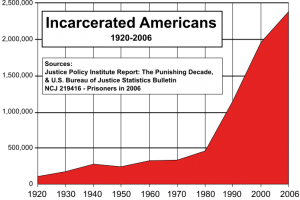As the new film adaptation of Victor Hugo’s classic “Les Miserables” hits theatres this week, such stories of unjust imprisonment are seen largely as things of the past. In that story, the main character Jean Valjean Was imprisoned for 19 years, five for stealing bread to feed his sister and the rest for escape attempts.
The irony is not lost in respect to two stories this week about the return of “Debtors Prison”.
Alternet reports:
“Prison time for poor people in debt remains something that is practiced throughout the United States, despite the fact that a 1983 Supreme Court decision ruled that a prisoner on probation who could not afford to pay his debts could not be thrown in jail for that reason. The practice of imprisoning people for debt is being fueled by the economic crash that has decimated state and city budgets. Debtor prisons are also on the rise thanks to the zeal of private companies that “file lawsuits against debtors and often fail to serve them with notice of court dates or intentionally serve them at incorrect addresses,” as the Brennan Center for Justice’s Inimai Chettiar noted. “When debtors do not show up, agencies procure arrest warrants from courts, leading to incarceration of the debtors. Bail is usually set at an amount equal to or higher than the original fees and fines they defendants couldn’t pay in the first place. All this has amounted to a return of debtors prisons.”
“Ethan Bronner, a reporter for the New York Times, profiled 31-year-old Gina Ray, who was fined $179 for a speeding ticket. Ray did not show up in court–she says the ticket had the wrong date on it–and her license was revoked. So the next time Ray got into trouble with the law was even worse. She was pulled over, and found to be driving without a license. “By then her fees added up to more than $1,500. Unable to pay, she was handed over to a private probation company and jailed — charged an additional fee for each day behind bars,” wrote Bronner.
The phenomenon of debtor prison creates a two-tiered justice system. For poor people unable to pay up money they owe from traffic infractions or other debts, jail becomes home for longer.”
Additionally, Raw Story reports that people are being jailed for being late paying rent:
“Under a state law in Arkansas, renters can be imprisoned for failing to pay their rent. According to a report by Human Rights Watch, titled “Pay the Rent or Face Arrest: Abusive Impacts of Arkansas’s Criminal Evictions Law,” hundreds of tenants each year are taken to court, fined and jailed under the state’s “failure to vacate” law.
“The failure-to-vacate law was used to bring charges against more than 1,200 Arkansas tenants in 2012 alone,” read the report. “This figure greatly understates the total number of people impacted by the law. The vast majority of tenants scramble to move out when faced with a 10-day notice to vacate rather than face trial — and with good reason.”
The report continued, “Making matters considerably worse, the law strongly discourages accused tenants from pleading not guilty. Those who do are required to deposit the total amount of rent they allegedly owe with the court, which they forfeit if they are found guilty. Tenants who are unable to deposit the rent amount but plead not guilty anyway face substantially harsher fines and up to 90 days in jail. Tenants who plead guilty face none of this.”
Since the beginning of the “war on drugs” which has been used unjustly against the poor and minorities, we have seen the evolution of “The Prison Industrial Complex”.
From Wikipedia:
“Prison Industrial Complex (PIC) is a term used to attribute the rapid expansion of the US inmate population to the political influence of private prison companies and businesses that supply goods and services to government prison agencies. The term is analogous to the military–industrial complex that President Dwight D. Eisenhower warned of in his famous 1961 farewell address. Such groups include corporations that contract prison labor, construction companies, surveillance technology vendors, lawyers, and lobby groups that represent them. Activists have described the Prison-Industrial Complex as perpetuating a belief that imprisonment is a quick fix to underlying social problems such as homelessness, unemployment, drug addiction, mental illness, and illiteracy.
The promotion of prison building as a job creator and the use of inmate labor are also cited as elements of the prison-industrial complex. The term often implies a network of actors who are motivated by making profit rather than solely by punishing or rehabilitating criminals or reducing crime rates. Proponents of this view believe that the desire for monetary gain has led to the growth of the prison industry and the number of incarcerated individuals.”
————————————————
So here we have a for-profit prison system, with incentives to spread an even larger dragnet to sweep new raw materials (prisoners) into the system. Recent reports have detailed how judges have recieved payment for supplying a steady stream of inmates.
Additionally, private corporations are buying State-owned prisons, paid for by taxpayers with contract agreements that the prisons must be maintained at near-full occupancy.
This is the recipe for a whole new form of slave labor, with felons being returned to society with virtually no civil rights and a fast-track back to the prison factory. Watch for this to steadily increase, it’s a growth industry with a frighteningly workable business plan.


